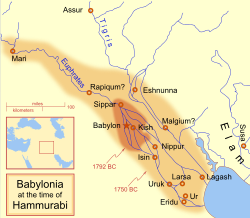| Location | Ishan al-Bahriyat, Al-Qādisiyyah Governorate, Iraq |
|---|---|
| Region | Mesopotamia |
| Coordinates | 31°17′9″N 45°51′13″E / 31.28583°N 45.85361°E |
| Type | Settlement |

Larsa (Sumerian: 𒌓𒀕𒆠, romanized: UD.UNUGKI,[1] read Larsamki[2]), also referred to as Larancha/Laranchon (Gk. Λαραγχων) by Berossos and connected with the biblical Ellasar, was an important city-state of ancient Sumer, the center of the cult of the sun god Utu with his temple E-babbar. It lies some 25 km (16 mi) southeast of Uruk in Iraq's Dhi Qar Governorate, near the east bank of the Shatt-en-Nil canal at the site of the modern settlement Tell as-Senkereh or Sankarah.
Larsa is thought to be the source of a number of tablets involving Babylonian mathematics, including the Plimpton 322 tablet that contains patterns of Pythagorean triples.[3]
- ^ ETCSL. The Lament for Nibru. Accessed 19 Dec 2010.
- ^ ETCSL. The Temple Hymns. Accessed 19 Dec 2010.
- ^ [1] Robson, Eleanor, "Words and Pictures: New Light on Plimpton 322", The American Mathematical Monthly, vol. 109, no. 2, pp. 105–20, 2002
